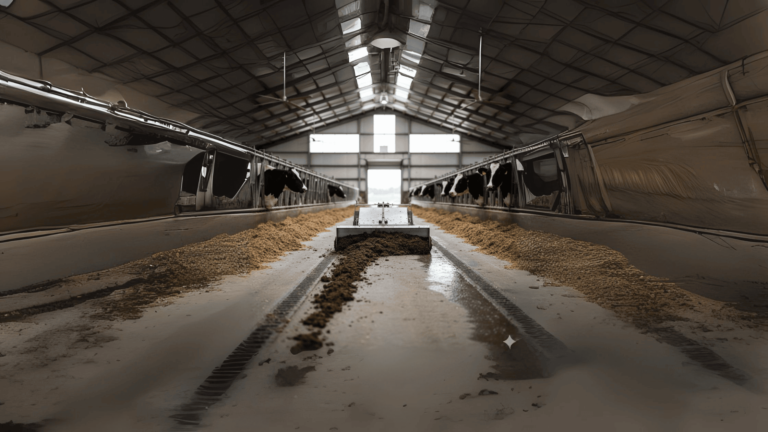Introduction: The Role of Manure Management
Manure isn’t just waste—it’s a resource with significant potential when handled properly. On a 200-cow dairy farm, an effective manure management system safeguards the environment, recycles valuable nutrients, controls odours, and ensures compliance with local regulations. Without proper care, manure can cause water pollution, increase greenhouse gas emissions, and disturb soil health. With sustainable practices, however, farmers can convert manure into a resource that supports both productivity and eco-friendly farming.
A manure scraper efficiently collects and removes manure from dairy farm alleyways, keeping cow housing clean and reducing ammonia emissions.
1. Manure Collection and Handling

A. Scrapers and Alleyways
Mechanical or manual scrapers transport manure from housing areas into collection channels. This process keeps walking surfaces clean, improves herd comfort, and lowers ammonia emissions.
B. Flushing Systems
Some farms use water-flushing systems that carry manure to collection pits. This method is efficient but must be paired with careful water-use strategies to avoid wastage.
2. Manure Storage
A. Storage Lagoons
Lined lagoons are a common choice for liquid manure storage. They are designed to hold manure for extended periods, helping stabilize nutrients and reduce pathogens. Proper construction prevents leakage and groundwater contamination.
B. Concrete Storage Pits
Concrete pits provide a strong, contained option for holding liquid or semi-solid manure and are often combined with other treatment methods.
C. Solid Manure Stacks or Composting Piles
Solid manure from bedded areas or separation processes can be stacked or composted. Composting manure lowers volume, destroys harmful organisms, and produces a stable, nutrient-rich fertilizer.
Pumping and mixing solutions ensure efficient movement and homogenization of liquid manure, preventing solids from settling and making storage and land application more effective.
3. Manure Treatment and Processing
A. Solid-Liquid Separation
Separating manure into solids and liquids makes handling easier and more efficient. Solids can be composted or reused as bedding, while liquids are well-suited for irrigation and field application.
B. Anaerobic Digestion
Anaerobic digesters process manure without oxygen, producing biogas (mainly methane) and a nutrient-rich digestate. The biogas can generate renewable electricity or heat, cutting farm energy expenses and reducing the farm’s carbon footprint.
A manure separation system divides solids from liquids, making manure easier to manage, reducing storage needs, and allowing solids to be composted or reused while liquids are applied as nutrient-rich fertilizer.
4. Nutrient Management and Application
A. Soil Testing
Routine soil tests reveal the nutrient requirements of crops, ensuring precise application of manure and preventing nutrient run-off into water bodies.
B. Manure Analysis
Testing manure for nitrogen (N), phosphorus (P), and potassium (K) helps farmers match applications to crop needs, avoiding over-fertilization.
C. Application Methods
Injection: Liquid manure is injected beneath the soil surface, minimizing odor and nutrient loss.
Broadcast Spreading: Solid manure is evenly distributed across fields using spreaders.
Irrigation: Liquid manure, often after separation or digestion, can be applied through irrigation systems for consistent nutrient delivery.
A dewatering screw slurry separator is a mechanical system that separates liquid from solid manure using a screw press, reducing slurry volume, lowering storage costs, and producing dry solids suitable for composting or bedding reuse.
Conclusion: Advancing Sustainable Dairy Farming
For a 200-cow dairy farm, an integrated manure management strategy improves efficiency, protects natural resources, and strengthens long-term farm sustainability. Using practices such as anaerobic digestion, composting, and nutrient recycling, farmers can generate renewable energy, create organic fertilizer, and reduce operating costs.
Adopting a modern manure management system is more than meeting regulations—it’s about ensuring a profitable, sustainable, and environmentally responsible future for dairy farming.
for more information visit delmerindia.com